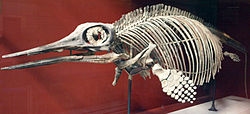Ophthalmosaurus icenicus
|
Ophthalmosaurus Temporal range: Middle - Late Jurassic, 165–145 Ma |
|
|---|---|
 |
|
| O. icenicus skeleton | |
| Scientific classification | |
| Kingdom: | Animalia |
| Phylum: | Chordata |
| Class: | Reptilia |
| Order: | †Ichthyosauria |
| Family: | †Ophthalmosauridae |
| Subfamily: | †Ophthalmosaurinae |
| Genus: |
†Ophthalmosaurus Seeley, 1874 |
| Species | |
|
|
| Synonyms | |
|
|
Ophthalmosaurus (meaning “eye lizard” in Greek) is an ichthyosaur of the Middle to Late Jurassic period (165 to 145 million years ago), named for its extremely large eyes. It had a graceful 6 m (19.5 ft) long dolphin-shaped body, and its almost toothless jaw was well adapted for catching squid. Major fossil finds of this genus have been recorded in Europe and North America.
Ophthalmosaurus had a body shaped like a tear-drop and a caudal fin like a half-moon. Its forelimbs were more developed than the hind ones, which suggests that the front fins did the steering while the tail did the propelling. Ophthalmosaurus' chief claim to fame is its eyes (some reaching about 9 inches or 220–230 mm in diameter) [2][3] which were extremely large in proportion to its body. The eyes occupied almost all of the space in the skull and were protected by bony plates (sclerotic rings), which most likely assisted to maintain the shape of the eyeballs [4] against water pressure at depth. The size of the eyes and the sclerotic rings suggests that Ophthalmosaurus hunted at a depth where there is not much light or that it may have hunted at night when a prey species was more active.
The genera Apatodontosaurus, Ancanamunia, Baptanodon, Mollesaurus, Paraophthalmosaurus, Undorosaurus and Yasykovia were all considered junior synonyms of Ophthalmosaurus by Maisch & Matzke, 2000. However, all recent cladistic analyses found that Mollesaurus periallus from Argentina is a valid genus of ophthalmosaurid.Ophthalmosaurus natans is probably not a species of Ophthalmosaurus either, in which case Baptanodon Marsh, 1880 is the only available generic name. Undorosaurus's validity is now accepted by most authors, even by Maisch (2010) who originally proposed the synonymy. and the two other Russian taxa might be also valid.Ophthalmosaurus chrisorum Russell, 1993 was moved to its own genus Arthropterygius in 2010 by Maxwell. On the other hand, Paraophthalmosaurus and Yasykovia are apparently valid and distinct from Ophthalmosaurus.
...
Wikipedia
